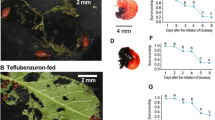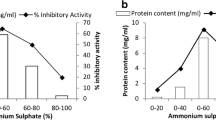Abstract
Chemical pesticides are the main tool used to handle lepidopteran insects in agriculture. However, in addition to causing environmental problems, the insects have acquired resistance to these molecules. Thus, the development of environmentally friendly biopesticides with higher specificity, such as organic protease inhibitors, has been encouraged. This work evaluated the inhibitory effects of two tripeptides, Pep1 and Pep2, obtained by removing the cleavage site of tripeptidyl substrates for trypsin-like proteases. Anticarsia gemmatalis were used as biochemical model and the trypsin-like activity of larvae exposed to different dosages of the tripeptides and protease inhibitors merged in an artificial diet was evaluated. Further, we selected one dose of each tripeptide to set a biological assay, where the total-proteolytic, cysteine-proteases, chymotrypsin-like and trypsin-like activities were determined. The tripeptides shown to have potential to inhibit trypsin-like serine proteases of A. gemmatalis midgut, being the lowest activity detected at doses of 170.4 μM and 251.2 μM for Pep1 and Pep2, respectively. The survival curves obtained using Kaplan-Meier estimators indicated that Pep2 and Pep1 affected survival when comparing to the control group. However, the effect of Pep1 on survival was more pronounced indicating the lowest percent of survival at the end of the larval phase (20%). In addition, larvae exposed to Pep1 maintained normal total proteolytic activity at the expense of the activities of chymotrypsin-like and cysteine proteases. Collectively, our findings revealed that the tripeptides, especially Pep1, exhibit toxic effects on A. gemmatalis and should be tested against other lepidopteran insects.



Similar content being viewed by others
References
Bradford, M. M. (1976). A rapid and sensitive method for the quantitation of microgram quantities of protein utilizing the principle of protein-dye binding. Analytical Biochemistry, 72, 248–254. https://doi.org/10.1006/abio.1976.9999.
Carneiro, E., Silva, L. B., Silva, A. F., Lopes, G. N., Pavan, B. E., Rodrigues, R. H. F., Carvalhinho, D. T., & Mielezrski, D. F. (2017). Lepidopteran pests associated with the soybean cultivars phenology. Bioscience Journal, 112–121. https://doi.org/10.14393/BJ-v34n1a2018-37172.
Dang, L., & Van Damme, E. J. M. (2015). Toxic proteins in plants. Phytochemistry, 117, 51–64. https://doi.org/10.1016/j.phytochem.2015.05.020.
Dantzger, M., Vasconcelos, I.M., Scorsato, V., Aparicio, R., Marangoni, S., & Macedo, M.L.R. (2015). Bowman–Birk proteinase inhibitor from Clitoria fairchildiana seeds: Isolation, biochemical properties and insecticidal potential. Phytochemistry, 118, 224, 235, 1016/j.phytochem.2015.08.013.
Erlanger, B. F., Kokowsky, N., & Cohen, W. (1961). The preparation and properties of two new chromogenic substrates of trypsin. Archives of Biochemistry and Biophysics, 95, 271–278. https://doi.org/10.1016/0003-9861(61)90145-X.
Gatehouse, J. A. (2002). Plant resitance towards insect herbivores: A dynamic interaction. New Phytologist, 156, 145–169. https://doi.org/10.1046/j.1469-8137.2002.00519.x.
Greene, G. L., Leppla, N. C., & Dickerson, W. A. (1976). Velvetbean caterpillar: A rearing procedure and artificial medium. Journal of Economic Entomology, 69, 487–488. https://doi.org/10.1093/jee/69.4.487.
Kuwar, S. S., Pauchet, Y., Vogel, H., & Heckel, D. G. (2015). Adaptive regulation of digestive serine proteases in the larval midgut of Helicoverpa armigera in response to a plant protease inhibitor. Insect Biochemistry and Molecular Biology, 59, 18–29. https://doi.org/10.1016/j.ibmb.2015.01.016.
Lopes, A. R., Juliano, M. A., Marana, S. R., Juliano, L., & Terra, W. R. (2006). Substrate specificity of insect trypsins and the role of their subsites in catalysis. Insect Biochemistry and Molecular Biology, 36, 130–140. https://doi.org/10.1016/j.ibmb.2005.11.006.
Machado, S. W., de Oliveira, C. F. R., Zério, N. G., Parra, J. R. P., & Macedo, M. L. R. (2017). Inga laurina trypsin inhibitor (ILTI) obstructs Spodoptera frugiperda trypsins expressed during adaptive mechanisms against plant protease inhibitors. Archives of Insect Biochemistry and Physiology, 95. https://doi.org/10.1002/arch.21393.
Marinho-Prado, J.S., Lourenção, A.L., Guedes, R.C., Pallini, A., Oliveira, J.A., & Oliveira, M.G.A. (2012). Enzymatic response of the eucalypt defoliator Thyrinteina arnobia (Stoll) (Lepidoptera: Geometridae) to a bis-benzamidine proteinase inhibitor. Neotropical Entomology, 41, 420, 425, 1007/s13744–012–0063-7.
Mendonça, E.G., Visôtto, L.E., Costa, N.C.S., Ribeiro, F.R.; Oliveira, J.A., & Oliveira, M.G.A. (2011). Caracterização enzimática de isoformas de cisteíno protease de Anticarsia gemmatalis (Hübner, 1818). Ciência e Agrotecnologia, https://doi.org/10.1590/S1413-70542011000300002
Meriño-Cabrera, Y., Zanuncio, J. C., da Silva, R. S., Solis-Vargas, M., Cordeiro, G., Rainha, F. R., Campos, W. G., Picanço, M. C., & Oliveira, M. G. O. (2018). Biochemical response between insects and plants: An investigation of enzyme activity in the digestive system of Leucoptera coffeella (Lepidoptera: Lyonetiidae) and leaves of Coffea arabica (Rubiaceae) after herbivory. Annals of Applied Biology, 172, 236–243. https://doi.org/10.1111/aab.12416.
Milano, P., Berti Filho, E., Parra, J. R., Oda, M. L., & Cônsoli, F. L. (2010). Effects of adult feeding on the reproduction and longevity of Noctuidae, Crambidae. Tortricidae and Elachistidae species. Neotropical entomology., 39, 172–180.
Mogaki, R., Okuro, K., & Aida, T. (2015). Molecular glues for manipulating enzymes: Trypsin inhibition by benzamidine-conjugated molecular glues. Chemical Science, 6, 2802–2805. https://doi.org/10.1039/c5sc00524h.
Moreira, L. F., Campos, W. G., Ribeiro, F. R., Guedes, R. N. C., & Oliveira, M. G. A. (2011). Survival and developmental impairment induced by the trypsin inhibitor bis-benzamidine in the velvetbean Caterpillar (Anticarsia gemmatalis). Crop Protection, 30, 1285–1290. https://doi.org/10.1016/j.cropro.2011.05.023.
Nauen, R., & Steinbach, D. (2016). Resistance to Diamide insecticides in Lepidopteran pests. Advances in Insect Control and Resistance Management. https://doi.org/10.1007/978-3-319-31800-4_12.
Oliva, M. L. V., Silva, M. C., Sallai, R. C., Brito, M. V., & Sampaio, M. U. (2010). A novel subclassification for Kunitz proteinase inhibitors from leguminous seeds. Biochimie, 92, 1667–1673. https://doi.org/10.1016/j.biochi.2010.03.021.
Oliveira, C. F. R., Souza, T. P., Parra, J. R. P., Marangoni, S., Silva-Filho, M. C., & Macedo, M. L. R. (2013). Insensitive trypsins are differentially transcribed during Spodoptera frugiperda adaptation against plant protease inhibitors. Comparative biochemistry and physiology. (part B). https://doi.org/10.1016/j.cbpb.2013.02.008.
Oliveira, M. G. A., de Simone, S. G., Xavier, L. P., & Guedes, R. N. C. (2005). Partial purification and characterization of digestive trypsin-like proteases from the velvet bean caterpillar. Anticarsia gemmatalis. Comparative Biochemistry and Physiology (Part B), 140, 369–380. https://doi.org/10.1016/j.cbpc.2004.10.018.
Oliveira, M. G. A., Rogana, E., Rosa, J. C., Reinhold, B. B., Andrade, M. H., Greene, L. J., & Mares-Guia, M. (1993). Tyrosine 151 is part of the substrate activation binding site of bovine trypsin. Journal of Biological Chemistry., 268, 26893–26903.
Paixão, G. P., Lourenção, A. L., Silva, C. R., Mendonça, E. G., Silva, P. L., Oliveira, J. A., Zanuncio, J. C., & Oliveira, M. G. (2013). Biochemical responses of Anticarsia gemmatalis (Lepidoptera: Noctuidae) in soybean cultivars sprayed with the protease inhibitor berenil. Journal of Agricultural and Food Chemistry, 61, 8034–8038. https://doi.org/10.1021/jf4027603.
Patarroyo-Vargas, A. M., Merino-Cabrera, Y. B., Zanuncio, J. C., Rocha, F., Campos, W. G., & Oliveira, M. G. A. (2017). Kinetic characterization of Anticarsia gemmatalis digestive serine-proteases and the inhibitory effect of synthetic peptides. Protein & Peptide Letters, 24. https://doi.org/10.2174/0929866524666170918103146.
Pilon, A. M., Campos, W. G., Silva, C. R., Cordeiro, G., Silva, C. R., & Oliveira, M. G. A. (2018). Protease inhibitory, insecticidal and deterrent effects of the trypsin-inhibitor benzamidine on the velvetbean caterpillar in soybean. Anais da Academia Brasileira de Ciências, 90, 3475–3482. https://doi.org/10.1590/0001-3765201820180159.
Saikhedkar, N. S., Joshi, R. S., Bhoite, A. S., Mohandasan, R., Yadav, A. K., Fernandes, M., Kulkarni, K. A., & Giri, A. P. (2018). Tripeptides derived from reactive Centre loop of potato type II protease inhibitors preferentially inhibit midgut proteases of Helicoverpa armigera. Insect Biochemistry and Molecular Biology, 95, 17–25. https://doi.org/10.1016/j.ibmb.2018.02.001.
Santos, M. F., Krüger, A. P., Turchen, L. M., Cutler, G. C., Oliveira, E. E., & Guedes, R. N. C. (2018). Non-targeted insecticidal stress in a pest species: Insecticides, sexual fitness and hormesis in the Neotropical brown stink bug. Annals of Applied Biology, 172, 375–383. https://doi.org/10.1111/aab.12428.
Schechter, I., & Berger, B. (1967). On the size of the active site of proteases. I. Papain. Biochemical and Biophysics Research Communications. https://doi.org/10.1016/S0006-291X(67)80055-X.
Souza, T. P., Dias, R. O., Castelhando, E. C., Brandão, M. M., Moura, D. S., & Silva-Filho, M. C. (2016). Comparative analysis of expression profiling of the trypsin and chymotrypsin genes from Lepidoptera species with different levels of sensitivity to soybean peptidase inhibitors. Comparative Biochemistry and Physiology (Part B), 196-197, 67–73. https://doi.org/10.1016/j.cbpb.2016.02.007.
Sparks, T. C., & Nauen, R. (2015). IRAC: Mode of action classification and insecticide resistance management. Pesticide Biochemistry and Physiology, 121, 122–128. https://doi.org/10.1016/j.pestbp.2014.11.014.
Srinivasan, A., Giri, A. P., & Gupta, V. S. (2006). Structural and functional diversities in lepidopteran serine proteases. Cellular & Molecular Biology Letters, 11, 132–154. https://doi.org/10.2478/s11658-006-0012-8.
Tomarelli, R. M. (1949). The use of azocasein as a substrate in the colorimetric determination of peptic and tryptic activity. Journal of Laboratory and Clinical Medicine, 34, 428–433.
Tschoeke, P. H., Oliveira, E. E., Dalcin, M. S., Silveira-Tschoeke, M. C., Sarmento, R., & Santos, G. R. (2019). Botanical and synthetic pesticides alter the flower visitation rates of pollinator bees in Neotropical melon fields. Environmental Pollution, 251, 591–599. https://doi.org/10.1016/j.envpol.2019.04.133.
Zhao, A., Li, Y., Leng, C., Wang, P., & Li, Y. (2019). Inhibitory effect of protease inhibitors on larval Midgut protease activities and the performance of Plutella xylostella (Lepidoptera: Plutellidae). Frontiers in Physiology. https://doi.org/10.3389/fphys.2018.01963.
Zhao, P., Wang, G. H., Dong, Z. M., Duan, J., Xu, P. Z., Cheng, T. C., Xiang, Z. H., & Xia, Q. Y. (2010). Genome-wide identification and expression analysis of serine proteases and homologs in the silkworm Bombyx mori. BMC Genomics, 11, 405. https://doi.org/10.1186/1471-2164-11-405.
Zhu-Salzman, K., & Zeng, R. (2015). Insect response to plant defensive protease inhibitors. Annual Review of Entomology, 60, 233–252. https://doi.org/10.1146/annurev-ento-010814-020816.
Acknowledgements
This study was supported by the National Institute of Science and Technology in Plant-Pest Interaction (INCT-IPP), the National Council for Scientific and Technological Development (Conselho Nacional de Desenvolvimento Científico e Tecnológico - CNPq), the Brazilian Federal Agency for the Support and Evaluation of Graduate Education (Coordenação de Aperfeiçoamento de Pessoal de Ensino Superior - CAPES) - Finance Code 001 and the Protection Foundation for Research in Minas Gerais (Fundação de Amparo à pesquisa de Minas Gerais - FAPEMIG).
Author information
Authors and Affiliations
Corresponding author
Ethics declarations
Conflict of interest
All of the authors declare that they have all participated in the design, execution, and analysis of the paper, and that they have approved the final version. Additionally, there are no conflicts of interest in connection with this paper, and the material described is not under publication or consideration for publication elsewhere.
Additional information
Publisher’s note
Springer Nature remains neutral with regard to jurisdictional claims in published maps and institutional affiliations.
Rights and permissions
About this article
Cite this article
de Oliveira, G., de Almeida Barros, R., da Silva Júnior, N.R. et al. Inhibitory effects of tripeptides to enzymatic activity and life cycle parameters of Anticarsia gemmatalis. Phytoparasitica 48, 823–831 (2020). https://doi.org/10.1007/s12600-020-00837-0
Received:
Accepted:
Published:
Issue Date:
DOI: https://doi.org/10.1007/s12600-020-00837-0




